

Tower and Town, November 2018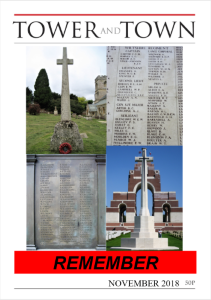 (view the full edition) (view the full edition)Marlborough Stories From 100 Years AgoThomas Maurice, a member of the Maurice medical family, was a Commander in the Royal Navy when he died aged 37 on the 27th May 1915. His parents were James and Mary Maurice of 40, High Street and his wife was Cicely Maurice. Thomas and Cicely were married in 1905 and at the time of the 1911 Census were living in Southsea Thomas was killed by an explosion when his ship, HMS Princess Irene, blew up while being loaded with mines in the Medway estuary just off Sheerness, prior to deployment on a mine-laying mission. Only six months earlier another parishioner from St Peter's had died in a similar explosion on board HMS Bulwark. A total of 352 people died in the Princess Irene explosion, including 273 officers and men, and 76 dockyard workers. 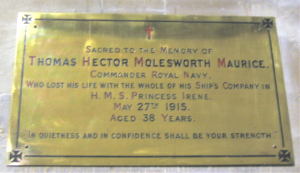 The devastation caused by the explosion was horrific. Flames rose 100 metres into the sky and a huge pall of smoke hung over the Kentish shoreline. A girl of nine was killed by flying debris on the Isle of Grain, and a ship moored half a mile away had its crane blown off. Wreckage of all sorts was scattered up to 20 miles from the scene of the explosion, from which there was just one survivor from the ship itself. An inquiry into the explosion blamed the accident on the hurried priming of the mines by untrained personnel; possible sabotage was ruled out by a later investigation. Thomas Maurice is remembered on the Portsmouth Naval Memorial, in the War Memorial chapel of St Peter's Church in Marlborough, and on a brass plaque at St George's, Preshute. Lionel Crow enlisted in 1914 with the 1st Canadian Mounted Rifles, having been previously employed by his father, a leather manufacturer in Angel Yard in Marlborough. He served with this battalion until his death on June 2nd 1916 in the Battle for Mount Sorrel. 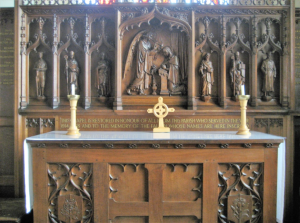 This piece of the high ground on the Ypres salient formed the 1916 British front line south-east of the city, and was held by three divisions of the Canadian Corps. The main thrust of the German attack came principally from two German divisions, which launched a sudden artillery bombardment, followed by an infantry attack, towards this high ground on 2 June. The German Army's aim was for a limited attack to clear the British Army off this advantageous high ground, the only high ground with dominating views for observation over the German sector that it possessed at this time. In so doing the hope was also to divert British attention to this area and thereby encourage the British to move troops here at a time when the Germans knew the British Army was planning an offensive for the Somme battlefield sector further south. The German artillery barrage at the start of the German attack and the stubborn defence by the Canadians resulted in many Canadian casualties and the high ground of the Canadian positions at Mount Sorrel was captured. A Canadian counter-attack on June 3rd was unsuccessful and the fighting continued here for another ten days. By June 13th the Canadians were again in possession of their old front line, and the German gains had for the most part been reinstated. Some attempts by the Germans in the early hours of June 14th to make counter-attacks were not successful and the battle drew to a close. The Canadian casualties by the end of the 13 days of fighting were just under 8,500, with 1,000 men killed and another 1,900 missing. Lionel is commemorated on the Menin Gate in Ypres, having no known grave, and on the memorial board in St Mary's Church in Marlborough. Francis Sprules: Francis' mother lived in St Peter's Terrace, and at the time of the war he was a baker at Marlborough College. He enlisted in the 1st/8th Royal Warwickshire Regiment in March 1916 and was sent to France later that summer. The following extract from the regimental war diary explains what happened on June 22nd 1917. 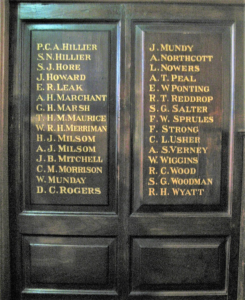 They were posted on the new front lines south-east of Arras which had been formed following the advances made by the British in April and May earlier that year. Trench raids were a regular part of military operations with a view to keeping the enemy on his toes, and hoping to gather information either directly or by capturing prisoners for interrogation. "At 11pm (21st) operations for raiding enemy at copse and dugouts in the vicinity commenced. Raiding party filed out from own lines and took up allotted positions until zero hour, A Company on the right and B Company on the left. At 1.35am (22nd) A Company occupied copse after blowing up mine in front. two prisoners were captured by B Company and several Germans killed. A Company experienced difficulty in retaining hold of copse in face of artillery fire from right flank. Eventually however the men emerged from copse and headed for the dugouts which could not be found. B Company successfully overcame all opposition and obtained all objectives. All operations being successful, raiding party commenced to withdraw at 2.15am, and reached our lines in safety by 3.15am. Casualties suffered during operations: A Company - 1 officer (who subsequently died of his wounds), and 9 Other Ranks wounded; B Company - 1 OR killed, and 2 OR wounded." Given this information we have to assume that Private Francis Sprules was that "OR killed". He was 31 years old when he died, and is buried not far from where he fell, in the Queant Road Cemetery at Buissy. Alfred Soames was the son of the Rector of Mildenhall, and at the time of the Battle of Loos in October 1915 was a Major in the 6th Battalion of The Buffs (The East Kent Regiment), having already won the DSO. His regiment was brought into a sector of the front line on the Loos battlefield on September 30th. On October 8th they repelled a strong German infantry attack, and then on October 13th they took part in what became the most famous action of the whole of the Battle of Loos - the attack on the Hohenzollern Redoubt. 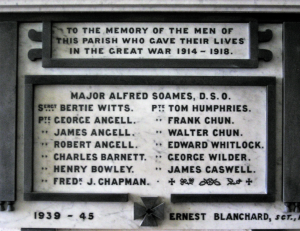 This redoubt was a heavily fortified part of the German front line guarding the route through to the L:ens coalfields, which the Germans were very keen to keep their hands on to help supply their war needs. A contemporary of Alfred's in a neighbouring regiment composed a poem about the Hohenzollern Redoubt, of which this is the first verse: Oh proud Hohenzollern, named after a King,The attack of October 13th was partially successful but at a huge cost to the participating troops. Another soldier taking part in the same attack described it as "absolute hell with the lid off. Dying and wounded all over the place. Shall never forget this day." The British problem was compounded by the weakness of the artillery support bombardment, the ineffective use of gas, and the shortage of hand grenades. After the war the official history commented: "The fighting [from 13–14 October] had not improved the general situation in any way and had brought nothing but useless slaughter of infantry". Alfred was 53 when he was killed in action in this battle on October 13th, and is commemorated on the Loos Memorial at Dud Corner cemetery, having no known grave. David Du Croz |